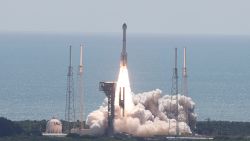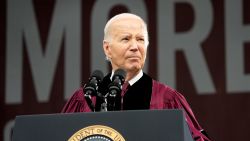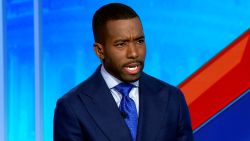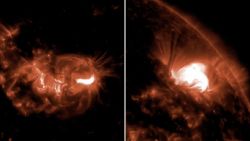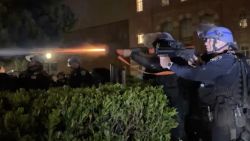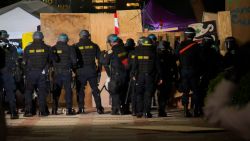“Sixteen shots and a cover-up” became a familiar chant from protesters who filled Chicago streets after 17-year-old Laquan McDonald was fatally shot by a police officer in 2014.
Now, five years later, the investigative report from Inspector General Joseph Ferguson reveals the full extent of what his office described as an elaborate cover-up by 16 officers and supervisors, including former police officer Jason Van Dyke, who fired the shots.
Van Dyke was sentenced to six years and nine months in prison in January following his conviction of second-degree murder and 16 counts of aggravated battery with a firearm.
The hundreds of investigative documents released this week – a move championed by Mayor Lori Lightfoot – accuse Van Dyke and 10 other officers of making false statements to exaggerate the threat posed by McDonald. Four others allegedly failed to ensure their video or audio recording systems were working, according to the report. And a former lieutenant who led the shooting investigation allegedly destroyed handwritten notes from witness interviews, the documents said.
Kevin Graham, president of the Fraternal Order of Police, said via email that he had “no faith” in the inspector general or the report. The IG’s investigation “missed basic problems in the (CPD) reporting system” which led to criminal charges against three officers who were later acquitted, he said. Former Detective David March, former officer Joseph Walsh and officer Thomas Gaffney – who were among the 16 officers singled out in the report – had been accused of falsifying police reports to protect Van Dyke.
Van Dyke’s attorney, Dan Herbert, said the newly released documents confirm his client was “taking the fall to protect the politicians and police command staff who determined the shooting was justified before realizing there would be a huge public outcry.”
“Chicago Police Department policy and training at the time justified the decision to shoot,” he said in a statement.
Here are some key takeaways from the IG’s report:
Ranking officers viewed video and agreed shooting was justified
In November 2015, current Police Superintendent Eddie Johnson – deputy chief at the time – attended a meeting with other ranking officers to review the shooting video and “understand that 16 shots was justified,” a lieutenant who was at the meeting told the inspector general’s office.
“Everyone in the meeting agreed the shooting was justified and that Van Dyke ‘used the force necessary to eliminate the threat,’” the IG report said.
The lieutenant told investigators that none of the top department brass in attendance “expressed any other concerns or contradictions to what has already been determined as far as the shooting,” the report said.
The CPD said in a statement Wednesday that Johnson was Deputy Chief of Area Central at the time and “not in any position to comment or object on the incident.” “The entire tenure of his administration has been built on reforms to the police department and re-centering everything we do around community policing, transparency and equity,” the statement said.
In 2016, Johnson told the Chicago Tribune – which has previously reported many of the IG’s findings after obtaining parts of the report – that he had seen the video at the time of the shooting but he did not disclose his reaction to it.
Other details from the IG’s report came out at Van Dyke’s trial.
Former CPD lieutenant who supervised investigation disposed of evidence
The report said a lieutenant who headed the department’s review of the shooting “brought discredit upon CPD by overseeing and participating in an untruthful, improperly documented, and unprofessional investigation of the shooting and by improperly disposing of material evidence.”
Additionally, the ranking officer – who is named in the documents – “made false statements and misleading characterizations in CPD reports he authored and approved, which served to exaggerate the threat McDonald posed,” according to the report.
One of the false statements was that police video from the scene “was viewed and found to be consistent with the accounts of all of the witnesses,” the report said.
Van Dyke shot and killed McDonald around 10 p.m. on October 20, 2014. A judge ordered the city to released dashcam video 13 months later.
The video showed McDonald walking down a road with a knife in his hand, but strolling away from officers when Van Dyke jumped out of his vehicle and pulled his gun. Van Dyke fired seconds after arriving on scene and took 15 seconds to fire 16 shots.
Shortly before he was shot, McDonald never faced Van Dyke. He spun after being shot and crumpled to the ground, his body stiff as he fell. Van Dyke continued to fire, unloading every round from his 9-mm Smith & Wesson handgun. The teen was struck by all 16 bullets, most of them while he was limp on the ground.
Numerous statements attributed by the lieutenant to witnesses in his report on the shooting were refuted by video evidence. They included police claims that McDonald pointed his knife at Van Dyke, who was forced to backpedal and fired to stop an imminent threat. Officers also backed Van Dyke’s claim that the teenager attempted to get up while pointing his knife at the officer.
The lieutenant is also accused of disposing of reports with handwritten notes of statements by civilian witnesses who were critical of Van Dyke’s actions, the report said. He failed to document the disposal, according to the report.
The inspector general would have recommended the lieutenant’s firing, but he resigned in May 2016 after the start of the IG investigation, the report said.
Van Dyke made multiple statements contradicted by dashcam video
Van Dyke made numerous false statements to a detective that were not backed up by “the most objective and reliable evidence of the events that night” – the dashcam video, the report said.
Contrary to what the officer stated, McDonald never moved toward Van Dyke. And McDonald did not advance toward the officer and his partner, the report said.
“Seconds prior to the shooting, McDonald moved the knife from his right hip to the right side of his lower back, but this modest movement of the knife was not in the direction of Van Dyke” and his partner, the report said.
McDonald did not attempt to get up after he collapsed on the road.
“Upon being shot and falling to the street, McDonald never moved his legs or lower body,” the report said. “In addition, the video only shows McDonald’s upper body making small, intermittent movements as what appears to be puffs of smoke rise from his body.”
Officers failed to ensure audio systems and dashcams were working
Four officers failed to follow CPD rules and regulations on the operation of video and audio systems in their police vehicles, the report said.
The officers did not ensure that the systems were recording the events the night of the shooting. Even an officer who was in the vehicle that recorded the most complete footage made “false statements and material omissions” that served to exaggerate the threat McDonald posed, the report said.
Former deputy chief approved false reports from officers
A former deputy chief who was on-call incident commander that night approved false “tactical response reports” and “officer battery reports” submitted by officers, the report said. The ranking officer retired after the IG’s office completed its investigation.
The deputy chief also falsely said in Van Dyke’s tactical response report that McDonald “continued to approach” the officer. He then checked a box that stated, “I have concluded that the member’s actions were in compliance with department procedures,” the report said.
The supervising officer did not check another box stating that further investigation was needed.
CNN’s Bill Kirkos and Brad Parks contributed to this report.


